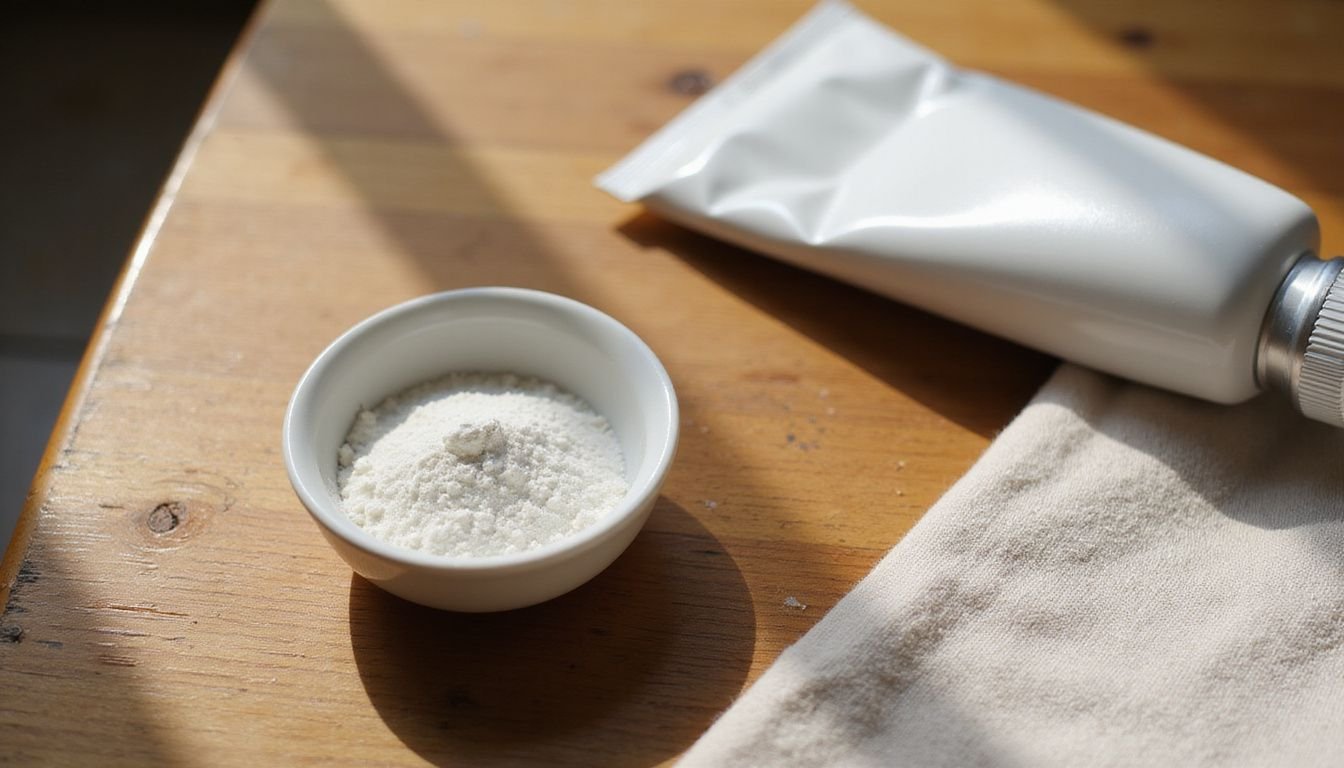Scratches on floor tiles can ruin the look of any home. Many house owners and parents worry when they see marks or scuffs on their bathroom, kitchen, or hallway tiles. Even a tiny scratch can be hard to ignore, especially if it stands out against clean, shiny floors.
Fact shows that both ceramic and porcelain tiles are strong but still get scratched from heavy furniture, dropped items, or pet claws. The good news is that simple methods exist for those searching for easy ways of how to remove scratches from floor tiles easily at home.
This guide breaks down quick fixes and proven products you can use without calling in a professional. Find smart tips below that make tile scratch removal much easier than most people think!

Methods to Remove Light Scratches

You can use toothpaste to tackle minor scratches. Applying a baking soda paste can also help address surface marks effectively.
Use toothpaste for minor scratches
Toothpaste works as a simple solution for removing light scratches from ceramic or porcelain floor tiles. Homeowners should use a non-gel, white toothpaste and apply it directly to the scratched area.
Rub gently with a soft cloth in circular motions for up to 30 seconds. The mild abrasive in toothpaste helps smooth out surface marks without damaging glazed ceramic tile finishes.
Wipe away any residue with a damp microfiber cloth to reveal improved results. This easy DIY tile scratch repair technique can help reduce visible bathroom tile scratches and maintain the look of high-traffic floors.
If small marks remain, move on to using a baking soda paste for stubborn surface imperfections.
Apply baking soda paste for surface marks
Baking soda works as a gentle abrasive for easy tile floor scratch removal. Mix three tablespoons of baking soda with one tablespoon of water to form a paste. Spread the mixture over the scratched area and rub in small circles using a soft, damp cloth.
This method helps clean off surface marks without harming glazed ceramic tiles or porcelain floors.
After gently scrubbing, rinse away any residue with clean water. Dry the spot with a microfiber towel. For most light scratches on bathroom tile or ceramic surfaces, this home remedy provides fast results without harsh chemicals.
Many DIY tile scratch repair tips recommend baking soda because it is safe around children and pets while protecting tile finishes from further damage.
Techniques for Deeper Scratches
To address deeper scratches on floor tiles, one can utilize a tile scratch repair kit for a professional fix. Another effective technique involves the application of wax or epoxy to fill in and conceal the scratches, providing a seamless finish.
Use a tile scratch repair kit
A tile scratch repair kit offers a quick solution for deeper marks that stand out on ceramic or porcelain tiles. These kits usually contain a filler, color compounds, and finishing pads.
Anyone can follow the simple instructions to cover scratches and blend repairs into the surrounding floor. For bathroom tile scratch removal, choose a water-resistant formula.
Tile floor scratch removal using these kits works well for both glazed ceramic tile scratch removal and repairing scratches on porcelain tiles. House owners see immediate results without needing expensive help or replacing entire tiles.
DIY tile scratch repair products save money while protecting homes with kids or pets where accidents happen often.
Apply wax or epoxy to fill scratches
Applying wax or epoxy is an efficient way to conceal scratches on floor tiles. This method effectively hides the marks and restores the tiles to their original condition. The application of wax or epoxy forms a protective layer that not just conceals scratches but also improves the tiles’ ability to resist future damage.
This simple approach offers a cost-effective solution for preserving flawless floor tiles in homes and guarantees enduring durability.
Additional Tips for Scratch Removal
To remove scuff marks, consider using a soft eraser. For a smooth finish, polish the tiles with a microfiber cloth.
Use a soft eraser for scuff marks
To eliminate scuff marks on floor tiles, house owners and parents can effectively use a soft eraser. Gently rubbing the scuffed area with a soft eraser can help lift and minimize the appearance of these marks without damaging the tile’s surface.
This simple yet effective method is especially handy for addressing minor scuffs caused by shoes, furniture, or other daily activities, providing an easy DIY solution for maintaining pristine floor tiles.
Keep in mind to not scrub too vigorously; instead, apply gentle pressure when using the soft eraser to avoid inadvertently scratching or marring the tile further. By including this straightforward technique into regular maintenance routines, homeowners can ensure their floor tiles remain free from unsightly scuff marks, enhancing the overall aesthetic appeal of their living spaces while preventing unnecessary wear and tear on tiled surfaces.
Polish with a microfiber cloth for a smooth finish
Use a microfiber cloth to polish the tiles for a smooth, glossy finish. Gently buff the surface in circular motions until it achieves the desired sheen. The microfiber material is gentle on tile surfaces and helps to reduce streaks or residue, leaving your floor looking pristine and well-maintained.
For House Owners & ParentsKeywords: Floor tile maintenance, Tile floor care tips
Post-Construction Cleaning Tips for Newly Installed or Repaired Floor Tiles
After newly installing or repairing floor tiles, it’s important to follow these post-construction cleaning tips to maintain the tiles’ appearance and durability:
- Use a mild, pH-neutral cleaner to wipe down the entire tiled surface. This will remove any construction debris, dust, or grime that may have accumulated during the installation or repair process.
- Thoroughly rinse the cleaned area with clean water and allow it to dry completely before walking on the tiles or placing any furniture or fixtures on them.
- Apply a high-quality tile sealer to protect the tiles from stains, moisture, and everyday wear and tear. Be sure to follow the manufacturer’s instructions for optimal application and drying times.
- Regularly sweep or vacuum the tiled surface to prevent dirt buildup, and promptly address any spills or stains using appropriate cleaning products recommended for your specific tile type.
- Consider placing felt pads under heavy furniture legs to minimize scratching and scuffing on the newly installed or repaired floor tiles.
Conclusion
In conclusion, effectively eliminating scratches from floor tiles can be accomplished using straightforward methods and techniques. Homeowners and parents can use everyday items such as toothpaste or baking soda to efficiently eliminate light scratches from ceramic or porcelain tiles.
For deeper scratches, they can choose tile scratch repair kits or utilize wax and epoxy to seamlessly fill in the scratches. Moreover, employing a soft eraser for scuff marks and polishing with a microfiber cloth will guarantee a smooth finish.
By following these uncomplicated steps, individuals can effortlessly preserve the beauty of their floor tiles.
FAQs
1. What are common ways to remove scratches from floor tiles?
Common methods include using a baking soda paste, applying a specialized tile scratch remover, or utilizing a magic eraser for minor scratches.
2. Can I use household items to fix scratches on my floor tiles?
Yes, many household items can help. For example, a mixture of baking soda and water creates an effective paste that can reduce the appearance of scratches.
3. How do I apply the scratch-removal method effectively?
First, clean the scratched area thoroughly. Then, apply your chosen solution with a soft cloth or sponge in gentle circular motions until you see improvement.
4. Are there preventive measures to avoid future scratches on my floor tiles?
To prevent future scratches, place mats at entryways and use furniture pads under heavy items; regular cleaning also helps maintain tile surfaces without damage.


